Table of contents
1. Figma – The collaborative unicorn
2. Sketch – The mac designer’s ally
3. Adobe XD – The comprehensive creative suite
4. InVision – The Interactive Storyteller
5. Axure RP – The enterprise solution
6. Marvel – The user-friendly marvel
7. Balsamiq – The low-fidelity maestro
8. Proto.io – The web-based wonder
9. Origami Studio – Facebook’s gift to designers
10. Principle – The motion maestro
11. Lunacy – The windows alternative
12. Flinto – The micro-interaction marvel
13. Wondershare Mockitt – The collaborative cloud tool
1. Figma – The collaborative unicorn
Figma is a powerful, cloud-based design and prototyping tool known for its real-time collaboration features. Designers and teams can work simultaneously on the same project, making it perfect for remote collaboration. Figma offers an extensive library of design assets, including UI components and templates, along with robust prototyping capabilities, making it a one-stop solution for UX designers. Figma ranks 1st on our list due to its second-to-none collaborative features, real-time editing, and capability to accommodate various design needs with a broad set of tools and plugins.
Pros:
- Real-time collaboration.
- Cross-platform (Windows, macOS, Linux).
- Extensive library of design assets.
- Robust prototyping capabilities.
Cons:
- Limited offline functionality in the free plan.
- Learning curve for new users.
Pricing:
- Free plan available.
- Paid plans starting at $12/user/month.
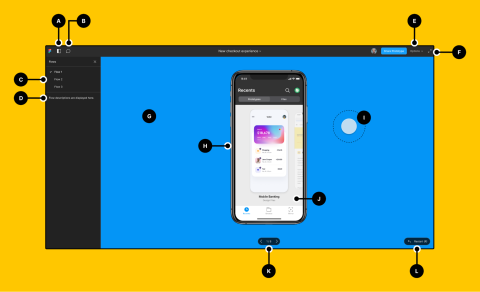
Source: Figma
2. Sketch – The mac designer’s ally
Sketch is an industry favourite among macOS users, providing a focused and efficient platform for interface design. Its simplicity and user-friendly interface make it a great choice for designers who prefer a native Mac experience. Sketch is highly extensible with a vast library of plugins, allowing you to customize your design environment and streamline your workflow.
Sketch ranks high on our list mainly for its simplistic and efficient interface that has been tailored specifically for interface design, making it a must for Mac users. If you want to take your Mac design projects even further, consider hiring a professional iOS designer from a reputable talent marketplace like Toptal, to help you streamline your design process and optimize your apps for higher success.
Pros:
- Mac-exclusive, optimized for macOS.
- Large library of plugins and integrations.
- Focused on interface design.
Cons:
- macOS-only (not suitable for cross-platform teams).
- Lacks some collaboration features.
Pricing:
- One-time purchase at $99 per user.
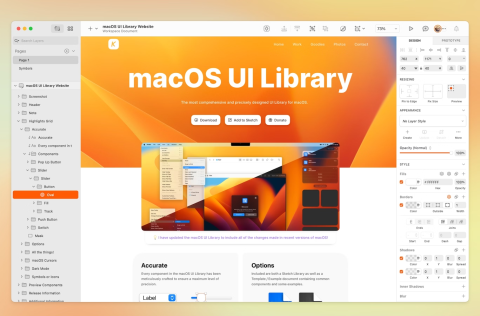
Source: Sketch
3. Adobe XD – The comprehensive creative suite
As part of the Adobe Creative Cloud, Adobe XD integrates seamlessly with other Adobe tools, making it a top choice for designers already using the Adobe suite. Adobe XD is an all-in-one solution for designing and prototyping. It also includes unique features like voice prototyping, which enables you to create voice-activated experiences.
A strong contender for our top 3 position, Adobe XD not only presents very robust prototyping capabilities but also features the added value of being able to integrate with other tools from the Adobe Creative Cloud suite. Making it a must for the many designers who are familiar with and choose to work with Adobe solutions.
Pros:
- Part of the Adobe Creative Cloud.
- Excellent for designing and prototyping.
- Voice prototyping feature.
Cons:
- Steeper learning curve for beginners.
- Integrations are limited to Adobe ecosystem.
Pricing:
- Free plan with limited features.
- Paid plans starting at $9.99/user/month.
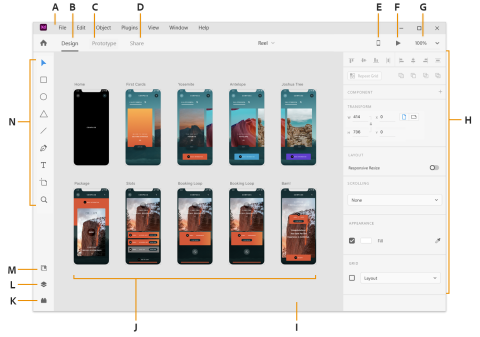
Source: Adobe
4. InVision – The interactive storyteller
InVision is a go-to tool for designers who need to create interactive and animated prototypes. It’s revered for its excellent collaboration features, making it easy for teams to share and iterate on designs. InVision offers a vast library of design and animation assets, making it an ideal choice for conveying your design concepts effectively. InVision is featured high in our list mainly for its strong emphasis on collaboration, animations, and sharing capabilities among design teams.
Pros:
- Outstanding for interactive and animated prototypes.
- Collaboration features.
- Extensive design and animation libraries.
Cons:
- Limited design capabilities (not a full design tool).
- Freehand feature not available in all plans.
Pricing:
- Free plan available.
- Paid plans starting at $7.95/user/month.
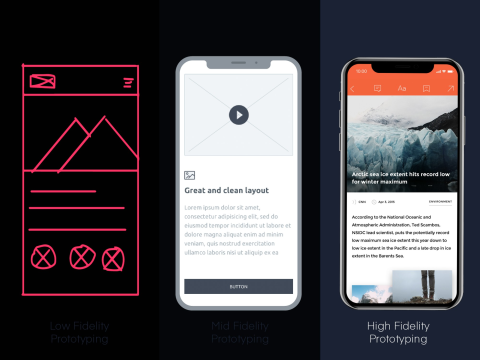
Source: InVision
5. Axure RP – The enterprise solution
Axure RP is designed for larger teams and more complex projects. It’s well-suited for enterprise-level design and prototyping, with a strong emphasis on wireframing and user flows. Axure RP allows you to create highly detailed and interactive prototypes, making it a favourite among UX designers working on complex and data-rich applications. Axure RP stands out in our list due to its robust wireframing, high-fidelity prototyping, and capabilities for complex application design.
Pros:
- Robust wireframing and prototyping.
- Ideal for complex projects.
- Enterprise-level features.
Cons:
- Steeper learning curve.
- Limited design features.
Pricing:
- Paid plans starting at $29/user/month.
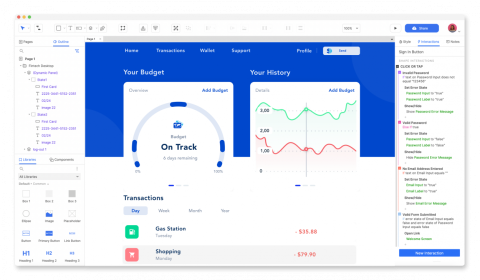
Source: Axure RP
6. Marvel – The user-friendly marvel
Marvel is renowned for its user-friendly and intuitive interface, making it a great option for designers of all levels of experience. It’s a versatile tool for quick and easy prototyping, providing a wide range of design and prototyping features. Marvel is particularly useful for designers looking to create prototypes swiftly and efficiently.
Pros:
- User-friendly interface.
- Quick and easy prototyping.
- Simple collaboration features.
Cons:
- Limited in advanced features.
- Better suited for simpler projects.
Pricing:
- Free plan available.
- Paid plans starting at $12/user/month.
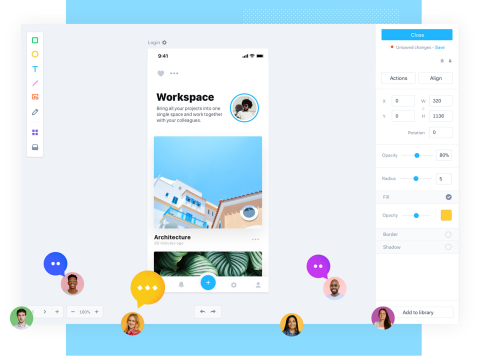
Source: Marvel
7. Balsamiq – The low-fidelity maestro
Balsamiq is the tool of choice for designers who want to focus on low-fidelity wireframing. It’s all about sketching out your ideas, allowing you to concentrate on the structure and content of your design without getting bogged down in the finer details. Balsamiq is an excellent choice for initial concept development and ideation.
Pros:
- Excellent for low-fidelity wireframing.
- Easy to sketch and iterate.
- Focus on structure and content.
Cons:
- Limited in high-fidelity design features.
- May require additional tools for full design.
Pricing:
- Paid plans starting at $9/user/month.
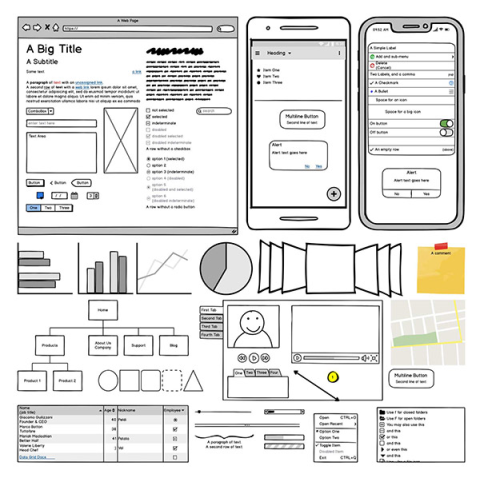
Source: Balsamiq
8. Proto.io – The web-based wonder
Proto.io is a web-based prototyping tool that simplifies the design and prototyping process. It’s particularly effective for creating mobile app prototypes, with a focus on user-friendly interaction design. Proto.io offers a smooth web-based experience that’s accessible from anywhere, making it an excellent choice for remote collaboration and quick design iteration.
Pros:
- Web-based for easy access.
- Effective for mobile app prototyping.
- Interactive and user-friendly.
Cons:
- Limited design capabilities.
- Collaborative features may be basic.
Pricing:
- Free plan available.
- Paid plans starting at $24/user/month.
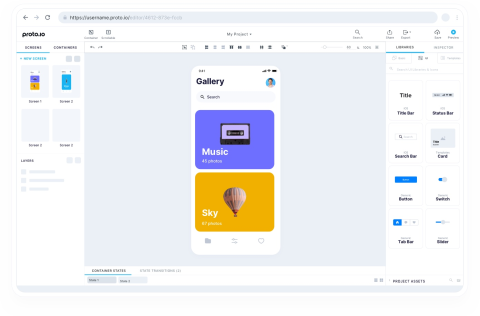
Source: Proto.io
9. Origami Studio – Facebook’s gift to designers
Developed by Facebook, Origami Studio is a unique tool that stands out for its ability to create interactive and animated prototypes. It’s particularly well-suited for designers who want to focus on micro-interactions and animations. Origami Studio is a niche tool that can help you add that extra layer of interactivity to your design projects.
Pros:
- Focus on interaction design.
- Allows for micro-interactions and animations.
- Backed by Facebook.
Cons:
- More niche, not a general design tool.
- Learning curve for new users.
Pricing:
- Free to use.
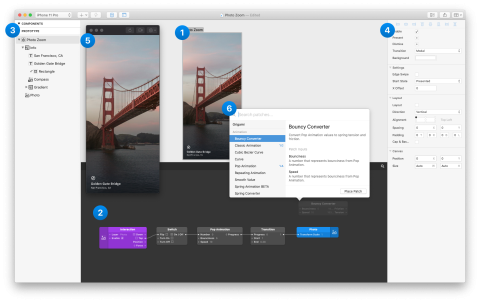
Source: Origami Studio
10. Principle – The motion maestro
Principle is a tool for designers who want to add stunning animations and interactions to their prototypes. It’s focused on interaction design and is ideal for mobile app prototyping. Principle’s intuitive timeline-based interface allows you to create complex animations with ease, making it an excellent choice for designers who prioritize motion and interaction design in their projects.
Pros:
- Excellent for creating animations.
- Focused on interaction design.
- Ideal for mobile app prototyping.
Cons:
- Lacks comprehensive design features.
- Learning curve for complex animations.
Pricing:
- Free trial available.
- One-time purchase at $129/user.
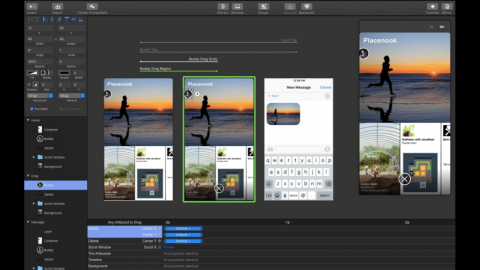
Source: Principle
Bonus for 2024
In the ever-evolving landscape of UX design and app prototyping, having the right tools at your disposal is like having a painter’s palette. Each tool on our list has its unique charm, catering to different needs and preferences.
As you dive into the world of UX design and app prototyping in 2024, remember that the best tool for you is the one that aligns with your design style, team collaboration requirements, and project complexity. The key is to experiment and find the perfect fit.
As a special bonus for our 2024 list, we’ve gone the extra mile to introduce you to three lesser-known and newer UX design and app prototyping tools!
These emerging tools offer distinct features and capabilities, making them worth exploring for your design projects. Whether you’re a Windows user looking for a platform-specific alternative, want to dive into micro-interactions and animations, or prioritize cloud-based collaboration, our additional recommendations cater to various design preferences and needs.
So, don’t miss the opportunity to discover these hidden gems and expand your creative toolkit even further.
11. Lunacy – The windows alternative
Lunacy is designed specifically for Windows users. It offers vector graphics editing and UI/UX design capabilities. With Lunacy, Windows users can create, edit, and prototype designs seamlessly.
Pros:
- Ideal for micro-interactions and animations.
- User-friendly for beginners.
- Excellent for app and web interactions.
Cons:
- May not be as feature-rich as some other tools.
- Lacks advanced design capabilities.
Pricing:
- Free trial available.
- Paid plans starting at $20/user/month.
12. Flinto – The icro-interaction marvel
Flinto focuses on micro-interactions and animations, making it an excellent choice for designers who want to create engaging and interactive prototypes. It’s available for macOS.
Pros:
- Ideal for micro-interactions and animations.
- User-friendly for beginners.
- Excellent for app and web interactions.
Cons:
- May not be as feature-rich as some other tools.
- Lacks advanced design capabilities.
Pricing:
- Free trial available.
- Paid plans starting at $20/user/month.
13. Wondershare Mockitt – The collaborative cloud tool
Wondershare Mockitt is a cloud-based design and prototyping tool. It’s known for its collaborative features, making it an excellent choice for teams working together on design projects. It supports both web and mobile app design.
Pros:
- Strong focus on collaboration.
- Cloud-based, allowing for easy sharing and collaboration.
- Offers user testing and handoff features.
Cons:
- May not be as feature-rich as some leading tools.
- Learning curve for new users.
Pricing:
- Free plan available.
- Paid plans starting at $12/user/month.
Remember, your creativity knows no bounds, and these tools are your canvas. So, embrace the possibilities, explore, and design your digital masterpieces! But don’t forget that one of the most critical steps is to test your designs with unbiased users. Their feedback is invaluable for refining your creations and ensuring they meet the needs and expectations of your target audience. Happy designing, and may 2024 be a year of boundless creativity and innovative design projects.

